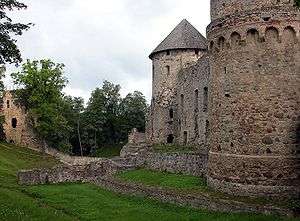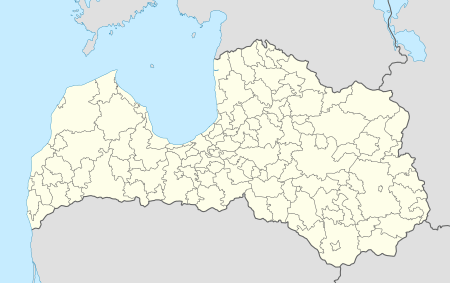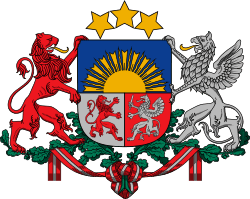Cēsis Castle
| Cēsis Castle | |
|---|---|
| Vidzeme, Latvia | |
 | |
 Cēsis Castle | |
| Coordinates | 57°18′50″N 25°16′08″E / 57.3137999°N 25.2687693°E |
| Type | Castle |
| Site information | |
| Condition | Ruins. |
| Site history | |
| Built | 13th. century. |
| Built by | Livonian Brothers of the Sword |
| Demolished | Great Northern War |
Cēsis Castle (German: Wenden) is a Livonian castle situated in Cēsis, Latvia. Its ruins are some of the most impressive castle ruins in the Baltic states. Once the most important castle of the Livonian Order, it was the official residence for the masters of the order.[1] It was partly destroyed during the Great Northern War.
History

German crusaders known as the Livonian Brothers of the Sword began construction of the castle (Wenden) near the hill fort in 1209. When the castle was enlarged and fortified, it served as the residence for the Order's Master from 1237 till 1561, with periodic interruptions.[1] In 1577, during the Livonian War, the garrison destroyed the castle to prevent it from falling into the control of Ivan IV of Russia, who was decisively defeated in the Battle of Wenden (1578).
In 1598 it was incorporated into the Polish-Lithuanian Commonwealth and Wenden Voivodship was created here. In 1620 Wenden was conquered by Sweden. It was rebuilt but destroyed again in 1703 during the Great Northern War by the Russian army and left in a ruined state. Already from the end of the 16th century, the premises of the Order's castle were adjusted to the requirements of the Cēsis Castle estate. In 1777 the castle estate was obtained by Count Carl Sievers and he had his new residence house built on the site of the eastern block of the castle, joining its end wall with the fortification tower.
In Literature
Cēsis Castle and its relationship to literature can be found in several Eastern European examples, most notably in Alexander Bestuzhev's short-story "Castle Wenden" (Wenden is German for Cēsis). In the story, Bestuzhev attempted to create a Gothic tale that is likely to have functioned as a partially political commentary on the state of Russian politics, due to his connection with the Decembrists. In the story, the castle plays a central role as the backdrop to a fictionalized account of the death of Wenno, the first Master of the Livonian Knights, an historical event still much debated in medieval studies. The story is in the Gothic tradition of The Castle of Otranto, while making ties to Russia's history in Latvia.[2]
Today
Since 1949, the Cēsis History Museum has been located in this New Castle of the Cēsis Castle estate. The front yard of the New Castle is enclosed by a granary and a stable-coach house, which now houses the Exhibition Hall of the Museum. Beside the granary there is the oldest brewery in Latvia, Cēsu Alus darītava, which was built in 1878 during a later Count Sievers' time, but its origins date back to the period of the Livonian Order. The Cēsis Castle park was laid out in 1812 and has the romantic characteristic of that time, with its winding footpaths, exotic plants, and the water of the pond reflecting the castle's ruins. Nowadays also one of the towers is open for tourists.
References
- 1 2 Thorkild Kjaergaard, Castles around the Baltic Sea: the illustrated guide, Malbork, 1994, p. 71: "After the defeat of the Order of Sword-Bearers, in the Battle of Saule in 1236, the first Master of the Livonian Order, Hermann Balke, chose Cesis as his residence and until 1561 (though not continuously) Cesis Castle was the residence of Masters of the Livonian Order, thus remaining a significant administrative and political centre."
- ↑ Bestuzhev-Marlinsky, Alexander, "Замок Венден", 1821, from Александр Александрович Бестужев-Марлинский: СОЧИНЕНИЯ В ДВУХ ТОМАХ, Том первый.
External links
 Media related to Cēsis Castle at Wikimedia Commons
Media related to Cēsis Castle at Wikimedia Commons- Construction of the Order’s Castle in Cesis, Latvia
Coordinates: 57°18′50″N 25°16′08″E / 57.3137999°N 25.2687693°E
